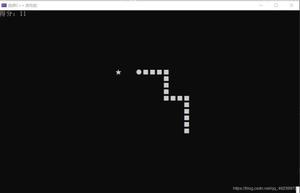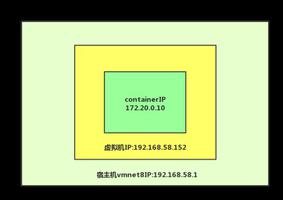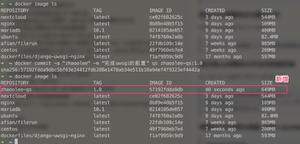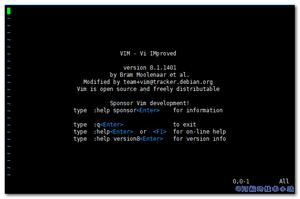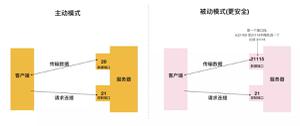docker基础:容器生命周期管理命令

容器是一种清理级、可移植、自包含的软件打包技术,使应用程序可以在几乎任何地方以相同的方式运行。
blog:https://www.cnblogs.com/Rohn/
目录
- 容器生命周期管理
- 运行容器
- 启停容器
- 杀掉容器
- 删除容器
- 暂停或恢复容器中所有的进程
- 创建一个新的容器但不启动它
- 在容器中执行命令
- 更新一个或多个容器的配置
容器生命周期管理
docker run:创建一个新的容器并运行一个命令;docker start/stop/restart:启停容器;docker kill:杀掉运行中的容器;docker rm:删除一个或多个容器;docker pause/unpause:暂停或恢复容器中的所有进程;docker create:创建一个新的容器但不启动它;docker exec:在运行的容器中执行命令;docker update:更新一个或多个容器的配置;
运行容器
语法如下:
docker run [OPTIONS] IMAGE [COMMAND] [ARG...]Options:
--add-host list Add a custom host-to-IP mapping (host:ip) (default [])
-a, --attach list Attach to STDIN, STDOUT or STDERR (default [])
--blkio-weight uint16 Block IO (relative weight), between 10 and 1000, or 0 to disable (default 0)
--blkio-weight-device weighted-device Block IO weight (relative device weight) (default [])
--cap-add list Add Linux capabilities (default [])
--cap-drop list Drop Linux capabilities (default [])
--cgroup-parent string Optional parent cgroup for the container
--cidfile string Write the container ID to the file
--cpu-count int CPU count (Windows only)
--cpu-percent int CPU percent (Windows only)
--cpu-period int Limit CPU CFS (Completely Fair Scheduler) period
--cpu-quota int Limit CPU CFS (Completely Fair Scheduler) quota
--cpu-rt-period int Limit CPU real-time period in microseconds
--cpu-rt-runtime int Limit CPU real-time runtime in microseconds
-c, --cpu-shares int CPU shares (relative weight)
--cpus decimal Number of CPUs (default 0.000)
--cpuset-cpus string CPUs in which to allow execution (0-3, 0,1)
--cpuset-mems string MEMs in which to allow execution (0-3, 0,1)
--credentialspec string Credential spec for managed service account (Windows only)
-d, --detach Run container in background and print container ID
--detach-keys string Override the key sequence for detaching a container
--device list Add a host device to the container (default [])
--device-read-bps throttled-device Limit read rate (bytes per second) from a device (default [])
--device-read-iops throttled-device Limit read rate (IO per second) from a device (default [])
--device-write-bps throttled-device Limit write rate (bytes per second) to a device (default [])
--device-write-iops throttled-device Limit write rate (IO per second) to a device (default [])
--disable-content-trust Skip image verification (default true)
--dns list Set custom DNS servers (default [])
--dns-option list Set DNS options (default [])
--dns-search list Set custom DNS search domains (default [])
--entrypoint string Overwrite the default ENTRYPOINT of the image
-e, --env list Set environment variables (default [])
--env-file list Read in a file of environment variables (default [])
--expose list Expose a port or a range of ports (default [])
--group-add list Add additional groups to join (default [])
--health-cmd string Command to run to check health
--health-interval duration Time between running the check (ns|us|ms|s|m|h) (default 0s)
--health-retries int Consecutive failures needed to report unhealthy
--health-timeout duration Maximum time to allow one check to run (ns|us|ms|s|m|h) (default 0s)
--help Print usage
-h, --hostname string Container host name
--init Run an init inside the container that forwards signals and reaps processes
--init-path string Path to the docker-init binary
-i, --interactive Keep STDIN open even if not attached
--io-maxbandwidth string Maximum IO bandwidth limit for the system drive (Windows only)
--io-maxiops uint Maximum IOps limit for the system drive (Windows only)
--ip string Container IPv4 address (e.g. 172.30.100.104)
--ip6 string Container IPv6 address (e.g. 2001:db8::33)
--ipc string IPC namespace to use
--isolation string Container isolation technology
--kernel-memory string Kernel memory limit
-l, --label list Set meta data on a container (default [])
--label-file list Read in a line delimited file of labels (default [])
--link list Add link to another container (default [])
--link-local-ip list Container IPv4/IPv6 link-local addresses (default [])
--log-driver string Logging driver for the container
--log-opt list Log driver options (default [])
--mac-address string Container MAC address (e.g. 92:d0:c6:0a:29:33)
-m, --memory string Memory limit
--memory-reservation string Memory soft limit
--memory-swap string Swap limit equal to memory plus swap: "-1" to enable unlimited swap
--memory-swappiness int Tune container memory swappiness (0 to 100) (default -1)
--name string Assign a name to the container
--network string Connect a container to a network (default "default")
--network-alias list Add network-scoped alias for the container (default [])
--no-healthcheck Disable any container-specified HEALTHCHECK
--oom-kill-disable Disable OOM Killer
--oom-score-adj int Tune host"s OOM preferences (-1000 to 1000)
--pid string PID namespace to use
--pids-limit int Tune container pids limit (set -1 for unlimited)
--privileged Give extended privileges to this container
-p, --publish list Publish a container"s port(s) to the host (default [])
-P, --publish-all Publish all exposed ports to random ports
--read-only Mount the container"s root filesystem as read only
--restart string Restart policy to apply when a container exits (default "no")
--rm Automatically remove the container when it exits
--runtime string Runtime to use for this container
--security-opt list Security Options (default [])
--shm-size string Size of /dev/shm, default value is 64MB
--sig-proxy Proxy received signals to the process (default true)
--stop-signal string Signal to stop a container, SIGTERM by default (default "SIGTERM")
--stop-timeout int Timeout (in seconds) to stop a container
--storage-opt list Storage driver options for the container (default [])
--sysctl map Sysctl options (default map[])
--tmpfs list Mount a tmpfs directory (default [])
-t, --tty Allocate a pseudo-TTY
--ulimit ulimit Ulimit options (default [])
-u, --user string Username or UID (format: <name|uid>[:<group|gid>])
--userns string User namespace to use
--uts string UTS namespace to use
-v, --volume list Bind mount a volume (default [])
--volume-driver string Optional volume driver for the container
--volumes-from list Mount volumes from the specified container(s) (default [])
-w, --workdir string Working directory inside the container
例子:
# 使用镜像nginx:latest,以后台模式启动一个容器,将容器的80端口映射到主机的80端口,主机的目录/data映射到容器的/datadocker run -p 80:80 -v /data:/data -d nginx:latest
启停容器
语法如下:
# 启动已经被停止的容器docker start [OPTIONS] CONTAINER [CONTAINER...]
Options:
-a, --attach Attach STDOUT/STDERR and forward signals
--detach-keys string Override the key sequence for detaching a container
-i, --interactive Attach container"s STDIN
# 停止运行中的容器
docker stop [OPTIONS] CONTAINER [CONTAINER...]
Options:
-t, --time int Seconds to wait for stop before killing it (default 10)
# 重启容器
docker restart [OPTIONS] CONTAINER [CONTAINER...]
Options:
-t, --time int Seconds to wait for stop before killing the container (default 10)
杀掉容器
语法如下:
docker kill [OPTIONS] CONTAINER [CONTAINER...]Options:
-s, --signal string Signal to send to the container (default "KILL")
删除容器
语法如下:
docker rm [OPTIONS] CONTAINER [CONTAINER...]Options:
-f, --force Force the removal of a running container (uses SIGKILL)
-l, --link Remove the specified link
-v, --volumes Remove the volumes associated with the container
暂停或恢复容器中所有的进程
语法如下:
# 暂停容器中所有的进程docker pause CONTAINER [CONTAINER...]
# 恢复容器中所有的进程
docker unpause CONTAINER [CONTAINER...]
创建一个新的容器但不启动它
语法同docker run。
在容器中执行命令
语法如下:
docker exec [OPTIONS] CONTAINER COMMAND [ARG...]Options:
-d, --detach Detached mode: run command in the background
--detach-keys string Override the key sequence for detaching a container
-e, --env list Set environment variables (default [])
--help Print usage
-i, --interactive Keep STDIN open even if not attached
--privileged Give extended privileges to the command
-t, --tty Allocate a pseudo-TTY
-u, --user string Username or UID (format: <name|uid>[:<group|gid>])
更新一个或多个容器的配置
语法如下:
docker update [OPTIONS] CONTAINER [CONTAINER...]Options:
--blkio-weight uint16 Block IO (relative weight), between 10 and 1000, or 0 to disable (default 0)
--cpu-period int Limit CPU CFS (Completely Fair Scheduler) period
--cpu-quota int Limit CPU CFS (Completely Fair Scheduler) quota
--cpu-rt-period int Limit the CPU real-time period in microseconds
--cpu-rt-runtime int Limit the CPU real-time runtime in microseconds
-c, --cpu-shares int CPU shares (relative weight)
--cpuset-cpus string CPUs in which to allow execution (0-3, 0,1)
--cpuset-mems string MEMs in which to allow execution (0-3, 0,1)
--help Print usage
--kernel-memory string Kernel memory limit
-m, --memory string Memory limit
--memory-reservation string Memory soft limit
--memory-swap string Swap limit equal to memory plus swap: "-1" to enable unlimited swap
--restart string Restart policy to apply when a container exits
原文链接:https://www.cnblogs.com/Rohn/archive/2020/07/12/13288941.html
以上是 docker基础:容器生命周期管理命令 的全部内容, 来源链接: utcz.com/z/518266.html

